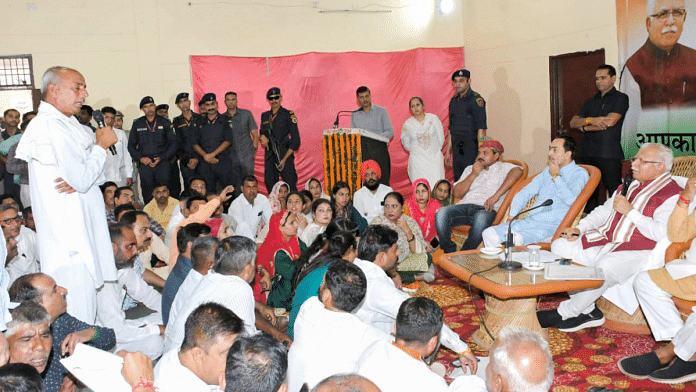Chandigarh: Ahead of the Haryana election, the Manohar Lal Khattar-led BJP-JJP government has announced the development of the Agroha Dham of the Agarwal community in Hisar district into a tourist destination on the lines of Rakhigarhi site, the largest site of Indus Valley Civilisation.
On Sunday, Khattar announced the establishment of a museum at the site of Agroha Dham, adding that the Centre has already approved the comprehensive development of the site and its surrounding areas jointly by the Archaeological Survey of India (ASI) and Haryana’s archaeology department. Sunday also happened to be Maharaja Agrasen Jayanti.
For this, a memorandum of understanding (MoU) will be signed between the ASI and the Haryana government.
“This museum will be a centre for preserving and presenting the historical and cultural treasures of Haryana. Visiting this museum will be an educational experience and promote Agroha’s importance as a cultural and historical destination. In addition, the government is going to develop Agroha, another historically significant site, along the lines of Rakhigarhi,” Khattar said at a press briefing in Panchkula.
Built between 1976 and 1984, Agroha Dham is a Hindu temple complex dedicated to Goddess Mahalakshmi, Saraswati, and Maharaj Agrasen, at Agroha. Believed to have been born during the era of Mahabharat, Maharaja Agrasen is a revered figure in the Agarwal community.

Rough estimates put Agarwal population at 4-5 percent in Haryana. Essel Group chairperson Subhash Chandra is the patron of Agroha Vikash Trust, Agroha Dham.
Urban local bodies and housing minister Kamal Gupta comes from this community and so is Haryana Speaker Gian Chand Gupta.
In Haryana Vidhan Sabha, Kamal Gupta (Hisar), Aseem Goyal (Ambala City), Sudhir Singla (Gurugram). Deepak Mangla (Palwal), Narender Gupta (Faridabad), Gian Chand Gupta (Panchkula), Ghanshyam Saraf (Bhiwani) and Gopal Kanda (Sirsa) are MLAs from the Agarwal community. While the first seven are from the BJP, Kanda leads the Haryana Lokhit Party that supports the ruling BJP in the state assembly.
Congratulating people on Maharaja Agrasen Jayanti, Khattar said the archaeological site is also a historically significant place. The site’s development will not only establish it as a revered centre of faith, but it will also gain recognition as a prominent tourist destination, he added.
Khattar said that more than 100 archaeological sites have been identified across Haryana, adding that these were being developed jointly by the central and state governments.
Agroha Dham Vashya Sama national president and Congress spokesperson Bajrang Dass Garg, however, said that the excavation was approved by the Centre on the demand of the Agroha Dham.
He said that the construction of two museums was already under progress at a cost of Rs. 30 crore and the artefacts recovered during excavations would be kept in those museums.
Giving details, a senior Haryana officer told ThePrint that Khattar had written to Union Culture Minister G. Krishan Reddy highlighting the importance of this archaeologically significant site to which the Centre has given a positive response.
The government’s objective is to enrich the historical and cultural legacy of Haryana, the officer said, adding that the project is aimed at transforming this site into a grand heritage location within Haryana.
“The discovery of coins from Agroha during previous excavations, along with references to its ancient name ‘Agradoka’ found in ancient literature, including the Mahabharata, provide substantial evidence supporting its status as the headquarters of the republic of Maharaja Agrasen. Agroha was strategically positioned on the ancient trade route connecting Taxila and Mathura, making it a crucial commercial hub and political activity. Previous excavations have underscored its potential, revealing evidence of five distinct cultural periods spanning from approximately 4th century to 14 century AD,” the officer said.
According to the website of the Haryana archaeology department, the primary efforts to discover Agroha’s past were made in 1888-89 under the supervision of C.J. Rodgers who was an archaeological surveyor in Punjab Circle.
“However, the initial excavations were small-scale and were carried for only 15 days to a depth of 16 ft. and unearthed solid brick walls and floors, paved causeways and an abundance of ashes and signs of burning. The objects which were recovered consisted of coins, beads, fragments of sculptures and terracotta. The excavation was restarted in the year 1938-39, though even this time, it could not be carried on for long due to the World War 2 but it provided major historical input towards Agroha’s existence,” the website of Haryana archaeological department reads.
“In 1978-79, the archaeology department began excavation work… It was at this time that people actually became aware of the extent of this great kingdom. Two more sessions i.e. 1979-80 and 1980-81 were carried out at Agroha by the department and revealed five cultural periods ranging from circa 4th century BC to 14th century AD,” it added.
(Edited by Tony Rai)
Also Read: Fought Mughals, defeated Akbar’s forces — why BJP is celebrating 16th-century Hindu king Hemu



